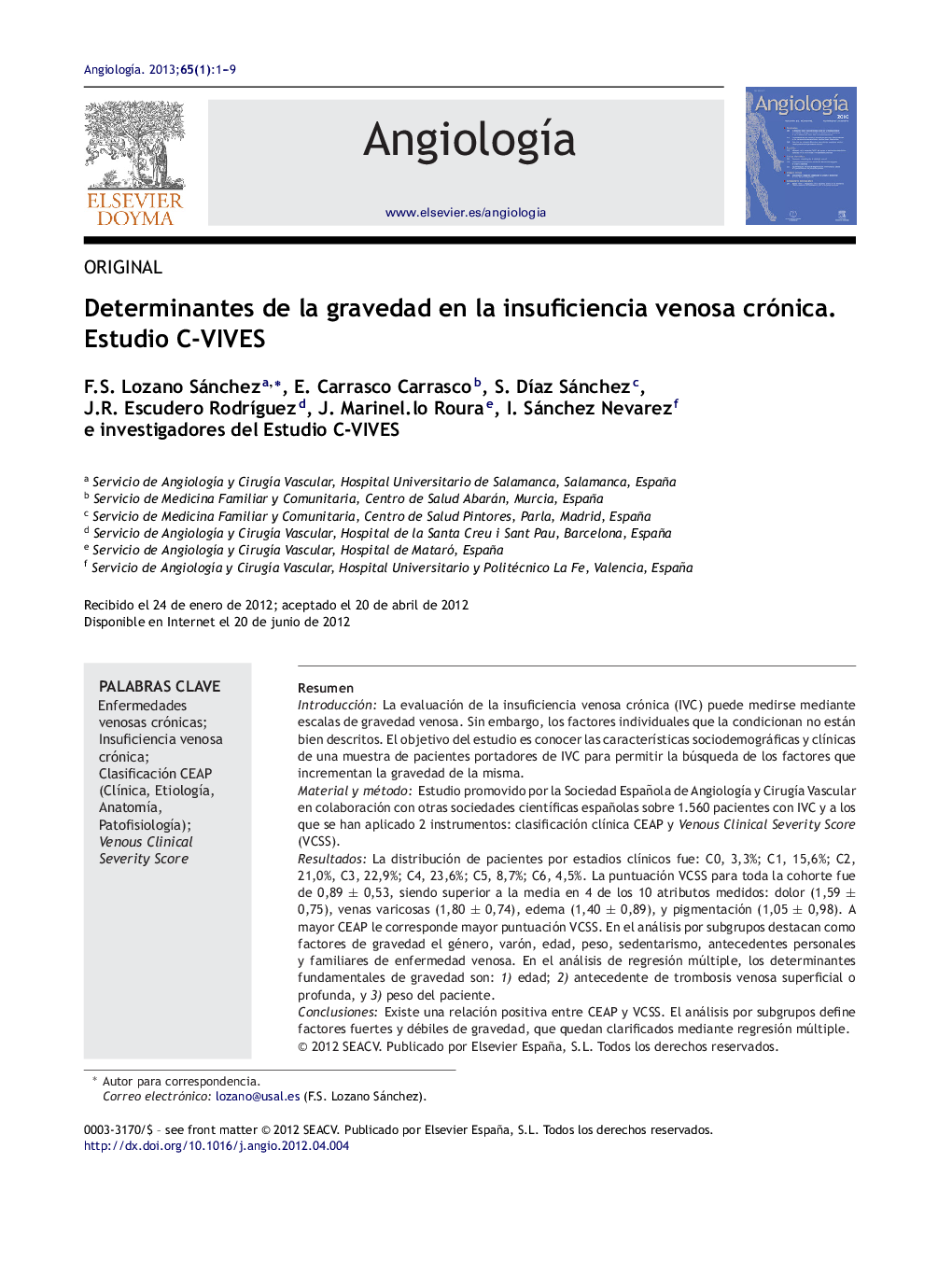| کد مقاله | کد نشریه | سال انتشار | مقاله انگلیسی | نسخه تمام متن |
|---|---|---|---|---|
| 2867612 | 1171098 | 2013 | 9 صفحه PDF | دانلود رایگان |

ResumenIntroducciónLa evaluación de la insuficiencia venosa crónica (IVC) puede medirse mediante escalas de gravedad venosa. Sin embargo, los factores individuales que la condicionan no están bien descritos. El objetivo del estudio es conocer las características sociodemográficas y clínicas de una muestra de pacientes portadores de IVC para permitir la búsqueda de los factores que incrementan la gravedad de la misma.Material y métodoEstudio promovido por la Sociedad Española de Angiología y Cirugía Vascular en colaboración con otras sociedades científicas españolas sobre 1.560 pacientes con IVC y a los que se han aplicado 2 instrumentos: clasificación clínica CEAP y Venous Clinical Severity Score (VCSS).ResultadosLa distribución de pacientes por estadios clínicos fue: C0, 3,3%; C1, 15,6%; C2, 21,0%, C3, 22,9%; C4, 23,6%; C5, 8,7%; C6, 4,5%. La puntuación VCSS para toda la cohorte fue de 0,89 ± 0,53, siendo superior a la media en 4 de los 10 atributos medidos: dolor (1,59 ± 0,75), venas varicosas (1,80 ± 0,74), edema (1,40 ± 0,89), y pigmentación (1,05 ± 0,98). A mayor CEAP le corresponde mayor puntuación VCSS. En el análisis por subgrupos destacan como factores de gravedad el género, varón, edad, peso, sedentarismo, antecedentes personales y familiares de enfermedad venosa. En el análisis de regresión múltiple, los determinantes fundamentales de gravedad son: 1) edad; 2) antecedente de trombosis venosa superficial o profunda, y 3) peso del paciente.ConclusionesExiste una relación positiva entre CEAP y VCSS. El análisis por subgrupos define factores fuertes y débiles de gravedad, que quedan clarificados mediante regresión múltiple.
IntroductionChronic venous insufficiency (CVI) can be evaluated using venous clinical severity scores. However, the individual factors that may lead to this condition have not been well described. The objective of this study is to analyse the sociodemographic and clinical characteristics of sample of patients who suffer from CVI in order determine the factors that increase the severity of their condition.Material and methodA study, promoted by the Spanish Society of Angiology and Vascular Surgery in collaboration with other scientific societies, was conducted on 1,560 patients with CVI using two measurement tools: CEAP (clinical grade, etiology, anatomy, pathophysiology) classification and Venous Clinical Severity Score (VCSS).ResultsThe patient distribution by clinical status (C0 to C5) was: C0: 3.3%; C1: 15.6%; C2: 21.0%, C3: 22.9%; C4: 23.6%; C5: 8.7%; C6: 4.5%. The VCSS score for the whole cohort was 0.89 ± 0.53, being greater than the mean in four of the ten measurements attributed to: pain (1.59 ± 0.75), varicose veins (1.80 ± 0.74), oedema (1.40 ± 0.89), and pigmentation (1.05 ± 0.98). A higher CEAP corresponded to a higher VCSS. In the analysis by subgroups, the risk severity factors were associated with, being male, weight, being sedentary, personal and family history of venous disease. In the multiple regression analysis, the main determining factors were: 1) age; 2) history of superficial of deep venous thrombosis; and 3) patient weight.ConclusionsThere is a positive relationship between CEAP and VCSS. The analysis by sub-groups defines strong and weak factors of severity, that are made clear using multiple regression analysis.
Journal: Angiología - Volume 65, Issue 1, January–February 2013, Pages 1–9